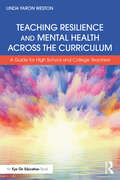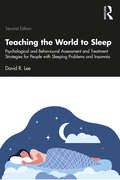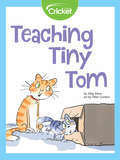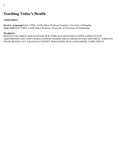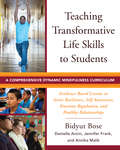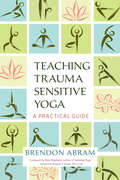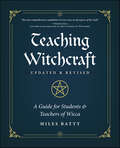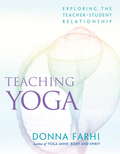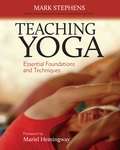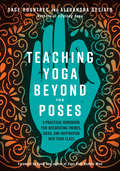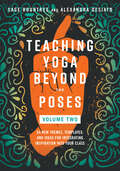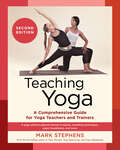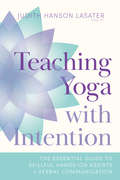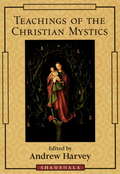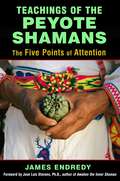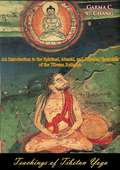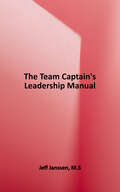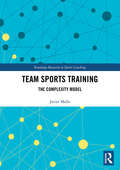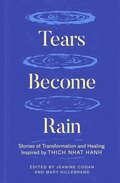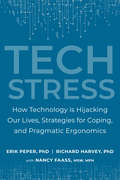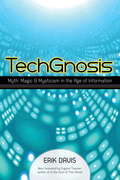- Table View
- List View
Teaching Resilience and Mental Health Across the Curriculum: A Guide for High School and College Teachers
by Linda Yaron WestonWritten by a teacher for teachers, Teaching Resilience and Mental Health Across the Curriculum is an integrative approach to pedagogy for educators at the high school and college level to survive, thrive, and sustain in the profession. Blending theory, research, and practice for a comprehensive program for teachers to incorporate well-being tools into the classroom, each of the book’s five foundations includes engaging information, strategies, real-world examples, interactive reflection questions, and activities that can be directly applied to teaching and life. Practical guidance in designing real-world curriculum is offered alongside accessible strategies for engagement, investment, and active learning in student-centered classrooms. An essential guide for teachers, it includes techniques for incorporating well-being that are grounded in culturally responsive teaching, trauma-informed instruction, mental health, resilience, and emotional literacy. Teachers will also gain insight on how to make the career sustainable through practices for self-compassion and authentic self-care so they can not only survive, but flourish in and out of school. For all the challenges that students and teachers face, this book defines what it means, and what it takes, to teach in today’s classrooms.
Teaching the World to Sleep: Psychological and Behavioural Assessment and Treatment Strategies for People with Sleeping Problems and Insomnia
by David R. LeeTeaching the World to Sleep provides a complete, science-based overview of sleep and sleep problems, from environmental, legal, and technological factors to assessment and treatment options. David R. Lee introduces the basic scientific concepts involved in sleep and provides a clear description of insomnias and the parasomnias. Teaching the World to Sleep discusses NICE-recommended Cognitive Behavioural Therapy for Insomnia (CBT-i) and the REST programme® and outlines considerations for at-risk groups, sleep and the law, and the application of dreams and dreaming in psychotherapy. This second edition includes a full update on research conducted since the publication of the first edition and includes new information on sleep in the legal setting, the rise of sleep apps and trackers and their impact on our sleep. Lee also considers neurodiversity, sleep in long Covid, rare and unusual sleep disorders and the delivery of treatment using the NHS-recommended stepped-care approach. Teaching the World to Sleep will be essential reading for psychotherapists, occupational therapists, and other professionals working with clients with sleep problems. It will also provide an accessible introduction to the science of sleep to readers looking to understand their own sleep problems.
Teaching Tiny Tom
by Meg MossTiny Tom the kitten learns all about felines and how they take care of themselves. In the process, he finds out about grooming, whiskers, litter boxes, and body language.
Teaching Today's Health
by David Anspaugh Gene EzellTeaching Today’s Health, Tenth Edition, balances comprehensive theory with a wealth of effective classroom activities to give you the tools you need to become successful health educators. This book’s strong background and depth in teaching methods prepares you for the challenges of today’s teaching environment. <p><p>Meaningful content enhancements include expanded coverage of bullying and obesity, body systems, and substance abuse and a new Creativity in the Classroom feature and an Index of Strategies). Important currency updates include a significantly updated nutrition chapter with new MyPlate and 2010 Dietary Guidelines and more technology coverage. Helpful Companion Website include all Worksheets available in PDF form, for easy copying to hand out to students in class, and a new easy-to-reference Glossary.
Teaching Transformative Life Skills to Students: A Comprehensive Dynamic Mindfulness Curriculum
by Annika Malik Bidyut Bose Danielle Ancin Jennifer FrankA classroom-ready program of evidence-based lessons in (1) stress resilience, (2) self-awareness, (3) emotion regulation, and (4) healthy relationships. Transform school and classroom climate, increase teacher sustainability, and build invaluable life skills in students with four ready-to-implement units incorporating mindful movement, yoga postures, breathing techniques, and more. The evidence-based and trauma-informed Transformative Life Skills (TLS) curriculum offers educators 48 scripted, 15-minute lessons designed to require minimal preparation and fit neatly within the busy school days of a single academic semester. Recommended by CASEL, it benefits all five core competencies of Social and Emotional Learning.
Teaching Trauma-Sensitive Yoga: A Practical Guide
by Brendon Abram Mark Stephens Margaret A. HowardA practical, hands-on, experienced-based guide from a military veteran turned yoga teacherBrendon Abram combines his first-hand experience with PTSD in the field and years of teaching to offer this practical guide to bringing trauma-sensitive yoga to both clinical and studio settings. Drawing on his work with military veterans, first responders, and survivors of domestic and sexual abuse, he emphasizes the importance of respecting the uniqueness of every individual and demonstrates how to use the foundational principles of yoga to create a safe experience. Abram explains that basic principles of yoga bring power to the practice and that breath, mindful movement, focused awareness, and acceptance of present-moment experience form the foundation of any yoga offering.
Teaching Witchcraft: A Guide for Students & Teachers of Wicca
by Miles BattyA Lost Underground Classic for Seekers and Instructors of the CraftTeaching Witchcraft is written for today's practitioners, both in coven groups and solitary study. Featuring more than thirty-five lessons that reflect current cultural perspectives and practices in the Wiccan community, this resource includes contemporary lesson guides and exam questions, as well as an emphasis on inclusivity.Miles Batty presents an extensive variety of topics, including spellcasting, ritual construction and procedures, the Wheel of the Year, the principles of Wiccan belief, and the four cornerstones of magick. You'll start with the fundamentals and progress through the Craft's many facets, from its history and tools to divination and etiquette. This step-by-step-guide also covers the faces of the goddess, sexuality in Witchcraft, correspondences, and magickal ethics. With lessons and study questions for every level of student, this is the essential resource for learning and teaching Witchcraft.
Teaching Yoga
by Donna FarhiDrawing on decades of experience in training Yoga teachers, Donna Farhi offers the first book to set professional standards for yoga teachers. Teaching Yoga explores with depth and compassion a variety of topics both practical and philosophical, including how to create healthy boundaries; the student-teacher relationship (including whether a sexual relationship is acceptable); how to create physical and emotional safety for the student; what is a reasonable class size; how much a class should cost; and how to conduct the business of teaching while upholding the integrity of Yoga as a philosophy, a science, and an art. A bonus CD features the author speaking about yoga ethics at a 2002 conference.
Teaching Yoga
by Donna FarhiDrawing on decades of experience in training Yoga teachers, Donna Farhi offers the first book to set professional standards for yoga teachers. Teaching Yoga explores with depth and compassion a variety of topics both practical and philosophical, including how to create healthy boundaries; the student-teacher relationship (including whether a sexual relationship is acceptable); how to create physical and emotional safety for the student; what is a reasonable class size; how much a class should cost; and how to conduct the business of teaching while upholding the integrity of Yoga as a philosophy, a science, and an art. A bonus CD features the author speaking about yoga ethics at a 2002 conference.
Teaching Yoga
by Donna FarhiDrawing on decades of experience in training Yoga teachers, Donna Farhi offers the first book to set professional standards for yoga teachers. Teaching Yoga explores with depth and compassion a variety of topics both practical and philosophical, including how to create healthy boundaries; the student-teacher relationship (including whether a sexual relationship is acceptable); how to create physical and emotional safety for the student; what is a reasonable class size; how much a class should cost; and how to conduct the business of teaching while upholding the integrity of Yoga as a philosophy, a science, and an art. A bonus CD features the author speaking about yoga ethics at a 2002 conference.
Teaching Yoga: Essential Foundations and Techniques
by Mariel Hemingway Mark StephensTeaching Yoga is an essential resource for new and experienced teachers as well as a guide for all yoga students interested in refining their skills and knowledge. Addressing 100% of the teacher training curriculum standards set by Yoga Alliance, the world's leading registry and accreditation source for yoga teachers and schools, Teaching Yoga is also ideal for use as a core textbook in yoga teacher training programs. Drawing on a wide spectrum of perspectives, and featuring more than 150 photographs and illustrations, the book covers fundamental topics of yoga philosophy and history, including a historical presentation of classical yoga literature: the Vedas, Upanishads, Bhagavad Gita, Yoga Sutras of Pataljali, and the main historical sources on tantra and early hatha yoga. Each of the eleven major styles of contemporary yoga is described, with a brief history of its development and the distinguishing elements of its teachings. Exploring traditional and modern aspects of anatomy and physiology, the book provides extensive support and tools for teaching 108 yoga poses (asanas), breathing techniques (pranayama), and meditation. Teaching Yoga offers practical advice for classroom setup, planning and sequencing classes, as well as the process involved in becoming a teacher and sustaining oneself in the profession. The book has over 200 bibliographic sources, a comprehensive index, and a useful appendix that lists associations, institutes, organizations, and professional resources for yoga teachers.From the Trade Paperback edition.
Teaching Yoga Beyond the Poses: A Practical Workbook for Integrating Themes, Ideas, and Inspiration into Your Class
by Sage Rountree Alexandra DeSiatoCreate class themes with yoga philosophy, inspirational quotes, and simple concepts to inspire and motivate students Experienced yoga instructors Sage Rountree and Alexandra DeSiato give yoga teachers the tools to find their voice and tap into innate wisdom. The authors offer ready-made, detailed themes to use in classes and provide flexible templates for building a toolkit of themes for future use. Teaching Yoga Beyond the Posesoffers guidance for both new and experienced teachers starting with a section on voice, authenticity, emulation, phrasing, practice, repetition, and finding inspiration. It continues with a second section that contains fifty-four complete themes that instructors can easily use in their own classes. The final section includes blank templates for instructors to create their own class themes and notes. With a unique angle and practical feel, this workbook will appeal to yoga teachers, teacher trainers, and at-home practitioners who want to move to the next level.
Teaching Yoga Beyond the Poses, Volume 2: 54 New Themes, Templates, and Ideas for Integrating Inspiration into Your Class
by Sage Rountree Alexandra DeSiatoVolume 2 of the bestselling guide for yoga teachers—design fresh, confident, and dynamic classes your students will love 54 inspired new themes: a full year of templates to engage, retain, and connect with your studentsThis companion volume—with all-new material—offers 54 ready-made ideas and templates to elevate your classes, refine your voice, and teach inspired themes with joy and confidence.Each chapter—like Rise to Joy, Less is More, and Rebel, Yogi!—introduces a series of updated themes. Authors Sage Rountree and Alexandra DeSiato offer practical upgrades to the bestselling first volume of Teaching Yoga Beyond the Poses, with new prompts, expanded notes, and thoughtful cues to help you connect with students and center their experiences in class. Each template offers useful guidance on:Expounding on your theme and connecting it to both personal and universal experiencesChants, quotes, mantras, poems, or songsSpecific practices that work with your themeDistilling your theme to a short sentence or intention for your classTakeaway ideas and helpful notesAny of the 54 class themes can be used as-is or molded to embody your own personal teaching style and authentic voice. Each includes insightful options for opening your class, suggestions for what to say during movements and pauses, and helpful ideas for closing out strong. Grounded in the knowledge that yoga philosophy is applicable to our daily lives—and its wisdom is for all of us—this book offers adaptable and easy-to-use ways to transform your classes, empower your students, and build richer, more meaningful connections by teaching beyond the poses and into the world.
Teaching Yoga for the Menstrual Cycle: An Ayurvedic Approach
by Anja Brierley LangeMenstrual cycle awareness is crucially important when trying to understand the needs of your yoga students and this guide will give you the knowledge you need to confidently address the menstrual cycle when teaching students in group and one-on-one settings via the principles of both western and Ayurvedic approaches. This book addresses the importance of the menstrual cycle and how Ayurvedic principles can best be applied to understand the anatomical, physiological and hormonal changes that take place during different stages and weeks throughout the menstrual cycle.Anja Brierley Lange highlights the purpose and importance of each phase of the menstrual cycle and how yoga teaching can and should be tailored accordingly to your students' menstrual needs.
Teaching Yoga, Second Edition: A Comprehensive Guide for Yoga Teachers and Trainers: A Yoga Alliance-Aligned Manual of Asanas, Breathing Techniques, Yogic Foundations, and More
by Mark StephensThe bestselling guide for yoga teachers and trainers, revised and updated—a comprehensive Yoga Alliance-aligned manual of asanas, breathing techniques, yogic foundations, and more.Revised and updated, Teaching Yoga by yoga expert Mark Stephens is one of the most popular resources for new and experienced teachers, and has been a trusted guide since its publication in 2010.This classic resource covers fundamental topics of yoga history and philosophy, as well as each of the 11 major styles of contemporary yoga. There is also practical advice for every stage of the teaching process, including tools for teaching 108 yoga poses (asanas), breathing techniques (pranayama), and meditation.The 2nd edition—adapted to meet the needs of the modern yoga teacher—features:Updated sections on yoga history and philosophyDiscussions of trauma-sensitive yogaCoverage of cultural appropriation, racism, and sexism in yoga An inclusive approach that expands beyond the traditional vinyasa flow styleNew photos and illustrations1-page summaries after each chapterAn extended list of references for further learningDeveloped to meet 100% of the teacher training curriculum standards set by Yoga Alliance, the world&’s leading registry and accreditation source for yoga teachers and schools, Teaching Yoga is ideal for use as a core textbook in yoga teacher training programs.
Teaching Yoga with Intention: The Essential Guide to Skillful Hands-On Assists and Verbal Communication
by Judith Hanson LasaterThe definitive guide to effective and appropriate communication through words and touch between yoga teachers and their students.Clear, effective verbal communication and judicious touch are two skills that Judith Hanson Lasater feels are essential for every yoga teacher. In Teaching Yoga with Intention, she gives pointed advice on how to interact verbally with students in class and how to appropriately use touch to make corrections. Drawing from her fifty years of yoga experience and her training in Nonviolent Communication, Lasater trains yoga teachers to effectively communicate not only technique, but also the more subtle lessons of respect, empathy, and compassion. She also shines an unflinching light on the use of touch in yoga. Teachers often use touch to create understanding and awareness in the poses. But this is a subtle art, and Lasater gives clear guidance on how, where, and when the use of touch can be used appropriately to further a student's development.In this book, Lasater also empowers students by encouraging them to take ownership of and responsibility for their practice. She covers myriad topics that can be difficult for students at any level to navigate, such as how and when to say "no" to an adjustment; keeping boundaries; when to leave a class; helping your teacher understand your needs; how to communicate your appreciation to your yoga teacher; and if and when to report a teacher's behavior. The skills that Lasater offers help create a safe environment for students to "own" their learning process, and to progress technically at their own speed.
Teachings of the Christian Mystics
by Andrew HarveyThe Christian mystics are the treasure of Western civilization--yet they remain little known among those of us who are potentially their spiritual heirs. Andrew Harvey's anthology confronts us with the mystics in their own words, to show us how well they serve, even now, as guides for the spiritual life--and to challenge our preconceived ideas about the path of Christianity. He has chosen selections that represent all eras of the Christian tradition, as well as the amazing range of people who have embodied it, people like Francis of Assisi, Meister Eckhart, Julian of Norwich, Teresa of Avila, Thomas Merton, Bede Griffiths, and many others.
Teachings of the Peyote Shamans: The Five Points of Attention
by James Endredy José StevensA rare in-depth look at the inner workings of Huichol shamanism • Describes the five sacred sites of the Huichol and their peyote ceremonies • Explains how the Huichol teachings of awareness, centered on the five points of attention, connect you to your true essence • Reveals the deep relationship between Huichol cosmology, Gnosticism, and Christianity, especially Jesus Christ and the Virgin Mary Taking place in the heart of the Huichol homeland in western Mexico, this book offers a rare in-depth look at the inner workings of Huichol shamanism, which is permeated with the use of the sacred peyote cactus. Outsiders are almost never allowed access to Huichol sacred sites and ceremonies; however, James Endredy, after years of friendship with Huichol families, earned the privilege nearly by accident. Swayed by persistent pleading, he agreed to take another gringo into the mountains to one of the Huichols’ ceremonial centers, and they were both caught. After trial and punishment, Endredy was invited to stay within the sacred lands for the festivities he had illegally intruded upon and found his initiation into the Huichol shamanic tradition had begun. Sharing his intimate conversations and journeys with the shaman he calls “Peyote Jesus,” the author explains how Huichol belief revolves around the five sacred directions, the five sacred sites, and the five points of attention. As Peyote Jesus explains, the five points of attention refer to dividing your awareness yet staying focused on your inner self. This is not a normal state of consciousness for most people, yet when we maintain these points of attention, we discover our true essence and move closer to God. Endredy undergoes dozens of spiritual journeys with peyote as he makes the pilgrimages to the five sacred Huichol sites with Peyote Jesus. He is shocked by his vision of the Virgin Mary while under peyote’s guidance and learns of the deep relationship--strictly on Huichol terms--between their cosmology, Gnosticism, and Christianity, especially Jesus Christ. Providing an inside look at the major ceremonies and peyote rituals of the Huichol, this unexpectedly powerful book reveals the key tenants of the Huichol worldview, their beliefs in the afterlife, and their spiritual work on behalf of all of humanity.
Teachings of Tibetan Yoga: An Introduction to the Spiritual, Mental, and Physical Exercises of the Tibetan Religion [Illustrated Edition]
by Garma C. C. ChangThe author-translator of this book was born in China of aristocratic parentage some fifty years ago. In early youth he became the disciple of a Buddhist Guru in a part of China near Tibet. His Guru sent him to Tibet to further his training. After eight years in Tibetan monasteries, six of them under one Guru, he went to school in the West to study animal husbandry and bring his knowledge hack to Tibet. The Communist victory in China and the Communist invasion of Tibet cut him off from returning. His devotion to Tibetan Buddhism is now expressed by translating into English its hitherto unknown teachings.This Book is an extremely concentrated introduction to the mental, physical, and spiritual exercises of Tibetan Buddhism, emphasizing the practice of Yoga exercises. The key to its understanding is the learning of Dumo--the generating of internal heat in one's body.Dumo's special meaning for Tibetan Yoga flows from the profoundly anti-ascetic and anti-pessimistic doctrine of Tantric Buddhism. The author means precisely what he says when he explains that opposites are also inseparable unities and that the best example of this is that the human body-mind can be made into the body of Buddha. Sexual bliss can become divine bliss.This work will both introduce the reader to the tranquility of yoga and, at the same time, lead him to explorations in the field of erotic mysticism.Richly illustrated throughout.
The Team Captain's Leadership Manual: The complete guide to developing team leaders whom coaches respect and teammates trust
by Jeff JanssenDesigned for both athletes and coaches of all sports, this one-of-a-kind Team Captain’s Manual details a proven 10-week leadership development program to build effective team leaders. Create team captains who: set the tone for your team, hold their teammates accountable to a higher standard, constructively confront their less disciplined teammates, know how to refocus their teammates when they are down or distracted, and take care of a lot of team problems so you don’t have to.
Team Sports Training: The Complexity Model (Routledge Research in Sports Coaching #10)
by Javier MalloTeam Sports Training: The Complexity Model presents a novel approach to team sports training, examining football (soccer), rugby, field hockey, basketball, handball and futsal through the paradigm of complexity. Under a traditional prism, these sports have been analyzed using a deterministic perspective, where the constituent dimensions of the sportsmen were independently examined and treated in isolation. It was expected that the body worked as a perfect machine and, once all the components were maximized, the sportsmen improved their performance. If the same closed recipe was applied to all the players that formed part of the squad, the global team performance was expected to be enhanced. As much as these reductionistic models seem coherent, when contrasted in practice we see that the reality of team sports is far more different from the closed conditions in which they were idealized. Team sports contain variable, heterogeneous and non-linear constrains which require the development of a different logic to organize their training. During the last years, ecological psychology, the dynamical systems theory or the constraints-led approach have opened interesting fields of research from which many conceptual foundations can be applied to team sports. Based in this contemporary framework, the current book presents the study of the players and the teams as complex systems, using coordination dynamics to explain the emergence of the self-organisation episodes that characterize them. In addition, this thinking line provides the reader with the ability to apply all these innovative concepts to their practical training scenarios. Altogether, it is intended to challenge the reader to re-think their training strategy and to develop an original theory and practice of training specific to team sports.
Team Sports Training: The Complexity Model (Routledge Research in Sports Coaching #10)
by Javier MalloTeam Sports Training: The Complexity Model presents a novel approach to team sports training, examining football (soccer), rugby, field hockey, basketball, handball and futsal through the paradigm of complexity. Under a traditional prism, these sports have been analyzed using a deterministic perspective, where the constituent dimensions of the sportsmen were independently examined and treated in isolation. It was expected that the body worked as a perfect machine and, once all the components were maximized, the sportsmen improved their performance. If the same closed recipe was applied to all the players that formed part of the squad, the global team performance was expected to be enhanced.As much as these reductionistic models seem coherent, when contrasted in practice we see that the reality of team sports is far more different from the closed conditions in which they were idealized. Team sports contain variable, heterogeneous and non-linear constrains which require the development of a different logic to organize their training.During the last years, ecological psychology, the dynamical systems theory or the constraints-led approach have opened interesting fields of research from which many conceptual foundations can be applied to team sports. Based in this contemporary framework, the current book presents the study of the players and the teams as complex systems, using coordination dynamics to explain the emergence of the self-organisation episodes that characterize them. In addition, this thinking line provides the reader with the ability to apply all these innovative concepts to their practical training scenarios. Altogether, it is intended to challenge the reader to re-think their training strategy and to develop an original theory and practice of training specific to team sports.
Tears Become Rain: Stories of Transformation and Healing Inspired by Thich Nhat Hanh
by Kaira Jewel Lingo John Bell Celia Landman32 mindfulness practitioners around the world reflect on encountering the extraordinary teachings of Zen master Thich Nhat Hanh, who passed away in January 2022, exploring themes of coming home to ourselves, healing from grief and loss, facing fear, and building community and belonging.Some moments change our lives. We experience wonder and relief when we realize we can be okay, just as we are. How do we then integrate these transformative moments into our daily life? Tears Become Rain is a collection of such stories, with one common inspiration: the teachings of mindfulness and compassion offered by the most influential meditation teacher of the past century, the Buddhist monk and peace activist Thich Nhat Hanh, who was nominated for the Nobel Peace Prize by Dr. Martin Luther King.The stories encapsulate the benefits of mindfulness practice through the experiences of ordinary people from 16 countries around the world. Some of the contributors were direct students of Thich Nhat Hanh for decades and are meditation teachers in their own right, while others are relatively new on the path.After her mother's death, Canadian author Vickie MacArthur writes poignantly of discovering a source of peace within herself at Thich Nhat Hanh's Plum Village monastery in France. Jamaican American English professor Camille Goodison uncovers the racism of academia and finds freedom from her toxic workplace by practicing the teachings of love and liberation as taught to her by Thich Nhat Hanh. Vietnamese doctor Huy Minh Tran shares how mindfulness helped him transform his traumatic past as a refugee so that he no longer suffers from nightmares. Norwegian Eevi Beck meditates on the teacher-student relationship and how Thich Nhat Hanh supported her marriage and then loss of her husband. For many, battling sickness, old age, and death—the death of loved ones and one's own—brings up overwhelming emotions of grief, anger, and despair but with the wisdom of Zen practice, Tears Become Rain shows again and again how people are able to find refuge from the storm in their lives and open their hearts to joy. Through sharing their stories, Tears Become Rain is both a celebration of Thich Nhat Hanh and a testament to his lasting impact on the lives of people from many walks of life.
Tech Stress: How Technology is Hijacking Our Lives, Strategies for Coping, and Pragmatic Ergonomics
by Erik Peper Richard Harvey Ph.D. Nancy Faass MSW MPHAn evolutionary approach to re-envisioning our relationship with technology--and reclaiming health, happiness, and sanity in a plugged-in worldEvolution shapes behaviors--and as a species, we've evolved to be drawn to the instant gratification, constant connectivity, and shiny lights, beeps, and sounds of our ever-present smartphones, laptops, and other devices. In earlier eras, these hardwired evolutionary patterns may have set us up for success, but today they confuse our instincts, leaving us vulnerable and stressed out from fractured attention, missed sleep, skipped meals, and all-over aches and pains.So how can we avoid the evolutionary pitfalls programmed into modern technology use? Erik Peper, Richard Harvey, and Nancy Faass offer real, practical tools to avoid the evolutionary traps that trip us up, helping us reduce physical strain, prevent sore muscles, combat brain drain, and correct poor posture. They first describe some of the problems associated with technology overuse, then offer strategies for mitigating technological stress, like how to: • Increase patience and calm while working at a computer • Improve communication with spouses, children, and co-workers during digital device usage • Arrange your work environment to best match your individual needs • Reduce hypervigilance and excessive cortisol production while using digital devices • Limit the bracing and freezing responses under stress that lead to 'blanking out' or not remembering details • Cultivate a sense of safety under conditions of workplace threat<
TechGnosis
by Eugene Thacker Erik DavisHow does our fascination with technology intersect with the religious imagination? In TechGnosis--a cult classic now updated and reissued with a new afterword--Erik Davis argues that while the realms of the digital and the spiritual may seem worlds apart, esoteric and religious impulses have in fact always permeated (and sometimes inspired) technological communication. Davis uncovers startling connections between such seemingly disparate topics as electricity and alchemy; online roleplaying games and religious and occult practices; virtual reality and gnostic mythology; programming languages and Kabbalah. The final chapters address the apocalyptic dreams that haunt technology, providing vital historical context as well as new ways to think about a future defined by the mutant intermingling of mind and machine, nightmare and fantasy.From the Trade Paperback edition.ology; programming languages and channeled texts. The final chapters address both apocalyptic and utopian dreams of the future of technology, providing historical context as well as new models for how to think and feel our way through an amazing, confusing, and disturbing time. This new edition features a foreword by Eugene Thacker as well as a new afterword reflecting on surveillance; the current tech bubble; the growth of superheroes, horror, and other "uncanny cultures" online; the growing backlash against technology; and the need to revitalize the cosmic imagination.ContentsIntroduction: crossed wires I imagining technologies II the alchemical fire III the gnostic infonaut IV techgnosis, american-style V the spiritual cyborg VI a most enchanting machine VII cyberspace: the virtual craft VIII the alien call IX datapocalypse X third mind from the sun XI the path is a network Afterword: beyond the boomFrom the Trade Paperback edition.
